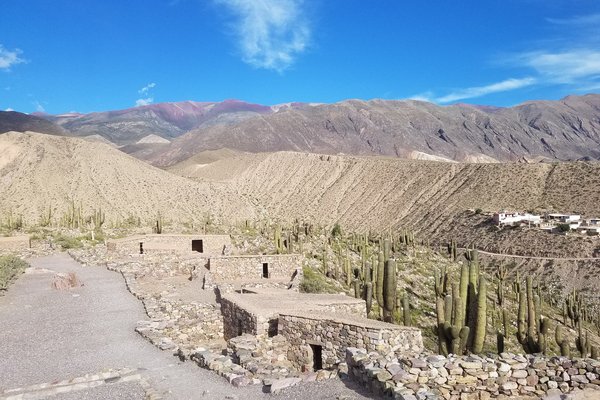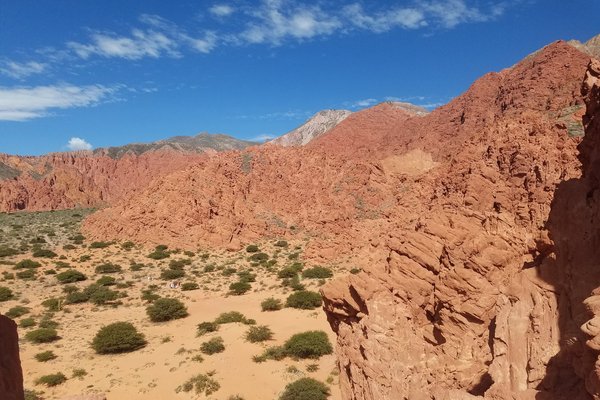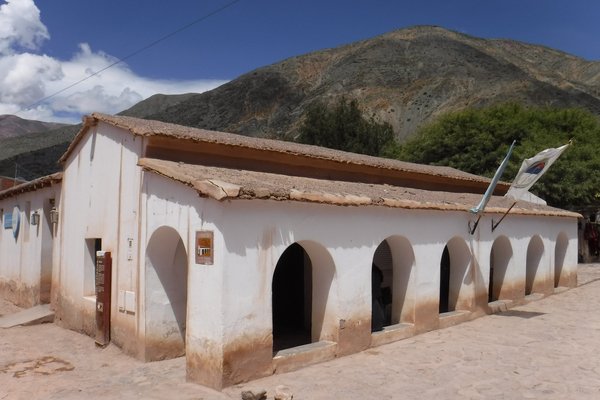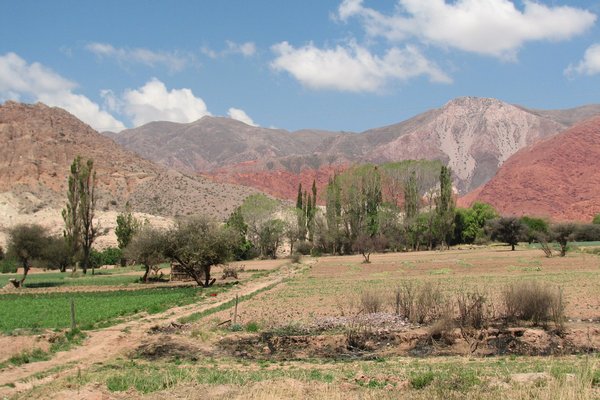Argentina
Quebrada de Humahuaca
The Quebrada de Humahuaca is a mountain valley that has been in use as a cultural route between the Andean highlands and the plains for over 10,000 years.
Numerous tracks, roads, settlements and fields testify to the civilizations that once lived here: hunter-gatherers, prehistoric farmers, indigenous Omaguacas, Inca, Spanish and the Argentine Republic. Especially notable are the stone-walled agricultural terraces of Coctaca. Due to its strategic position, the area was colonized by both the Inca and the Spanish, who were after the trade, minerals and agricultural products.
Community Perspective: Although set in a stunning natural setting, its cultural values are harder to grasp – the Pucará of Tilcara may be the best of the ancient sites. Frédéric spent 4 days in the area and covered several interesting places.
Site Info
Official Information
- Full Name
- Quebrada de Humahuaca (ID: 1116)
- Country
- Argentina
- Status
-
Inscribed 2003
Site history
History of Quebrada de Humahuaca
- 2003: Inscribed
- Inscribed
- Type
- Cultural
- Criteria
- ii
- iv
- v
Links
- UNESCO
- whc.unesco.org
- Official
-
- quebradadehumahuaca.com — Quebrada de Humahuaca
- Related
-
- lanacion.com.ar — Plan to revive the railway passing through the valley
- scielo.org.ar — Detailed information about Pucara de Tilcara
All Links
UNESCO.org
- whc.unesco.org — whc.unesco.org/
Official Website
- quebradadehumahuaca.com — Quebrada de Humahuaca
Related Resources
- lanacion.com.ar — Plan to revive the railway passing through the valley
- scielo.org.ar — Detailed information about Pucara de Tilcara
News Article
- March 11, 2017 internacional.elpais.com — An avalanche of stones falls on Tilcara
Community Information
- Community Category
- Cultural Landscape: Continuing
Travel Information
Recent Connections
-
Perfect Inscriptions
2003 -
Untranslated Toponyms
The name quebrada (literally "broken") … -
Largest cultural WHS
172,116 ha
Connections of Quebrada de Humahuaca
- Individual People
-
-
Tupac Inca Yupanqui
conquered it
-
- Geography
-
-
Andes
(2500-3500mtrs) -
Highest cultural WHS
Humahuaca 2,946 m -
Linear inscriptions
-
Antipodes points
HISTORIC CENTRE OF MACAO=QUEBRADA DE HUMAHUACA N22 11 28.651 E113 32 11.26 = S23 11 59.5 W65 20 55.9
-
- Trivia
-
-
Largest cultural WHS
172,116 ha -
Twin Towns
Tilcara and Maimara are in such strong rivalry that it sometimes comes to physical violence between their inhabitantsSee periodicolea.com
-
Slow Food Movement
Potatoes -
Minority communities
Most local population identifies as Kolla (who are the descendents of the Omaguaca). Their traditional language was Cacan but it was later given up in favour of Quechua (still spoken in the area) and Spanish -
Built or owned by Spanish
Posta de Hornillos, created by the colonial rulers in the Viceroyalty of the Río de la Plata
-
- History
-
-
Pre-Inca cultures
Omaguaca -
Qhapaq Nan (Inca)
-
- Architecture
-
-
Mudejar style
Most of the colonial churches in the valley are in the mudejar style -
Vernacular architecture
The valley also displays several churches and chapels and a vibrant vernacular architectural tradition. (Icomos -
Earth Architecture
-
- Damaged
-
-
Destroyed or damaged by Earthquake
Church of Tumbaya was destroyed in 1796. -
Destroyed during invasion
The Pucara at Tilcara was destroyed by the Spaniards and its inhabitants exiled.
-
- World Heritage Process
-
-
Perfect Inscriptions
2003 -
Reconstruction regarded as unsatisfactory
"There is one exception and that is the Pucara of Tilcara which was partially reconstructed in the 1940s and thus now has low integrity" (AB ev)
-
- Religion and Belief
-
-
Jesuit Order
Jesuit Church in Purmamarca
-
- Human Activity
-
-
Ateliers
The Argentinian painter Jos? Antonio Terry had his atelier in Tilcara. In his works he described the Quechua natives and the coulorful mountains. His atelier now serves as a museum. -
Art Colonies
Tilcara -
Cuzco School of Painting
Angels in Uquia -
Festivals
Pachamama ritual and Carnival -
Mummies
Tilcara museum holds a mummy that originates from San Pedro de Atacama (Chile) -
Man-made Terraces
The precolumbian site of Coctaca has agricultural terraces -
Cultural Routes
Quebrada de Humahuaca follows the line of a major cultural route, the Camino Inca -
Pictographs
"pictographs in black, white and red" -
Silver production
-
- Constructions
-
-
Caravanserai
Posta de Hornillos, a 16th century post for travellers to rest, modelled by the Spanish after the oriental caravanserais -
Pyramids
At the Pucara in Tilcara: ... stands a monument resembling a pyramid with a truncated top. It is a tribute to archeologists Juan D. Ambrosetti, Salvador Debenedetti and Eric Boman, and it was built by architect Mart?n Noel in 1935. -
Railways
The valley is crossed by an early 20th century railway (now defunct) -
Cemeteries
Tilcara: Cemetery at Pucara
-
- WHS on Other Lists
-
-
World Monuments Watch (past)
Pucara de Tilcara, 2012See www.wmf.org
-
- Timeline
-
-
Built in the 8th century
Agricultural practice in Coctaca started from 700 AD (nom file)
-
- Science and Technology
-
-
Botanical Gardens
Near the Pucara is the Botanic Garden of Heights displaying local Andean vegetation
-
- WHS Names
-
-
Untranslated Toponyms
The name quebrada (literally "broken") translates as a deep valley or ravine and is used in S America to designate a location where a stream which is usually dry or nearly so can be filled by heavy rain - in this case the Rio Grande. (Other place names using the word include Quebrada de las Conchas in Argentina, Quebrada de Cafayate in Peru, Quebrada de los Cuervos in Uruguay, and Quebrada Blanca in Chile)
-
News
- internacional.elpais.com 03/11/2017
- An avalanche of stones falls on Ti…
Recent Visitors
Visitors of Quebrada de Humahuaca
- Alejandro Lau
- Ali Zingstra
- Ammon Watkins
- Ana
- Anna Wludarska
- Assif
- Atila Ege
- basementonline
- Bill Maurmann
- Bodil Ankerly
- Carlos Sotelo
- Chantal den Haan
- Christravelblog
- Claire Bradshaw
- Doubanjiang
- Els Slots
- emvcaest
- Erik Jelinek
- Eva Kisgyorgy
- fedemarch92
- Felicité
- Filip Murlak
- Francky D'Hoop
- Frédéric M
- Gary Arndt
- Grzegorz Andruszkiewicz
- Hammeel
- Iain Jackson
- Janos
- Jan Zimmermann
- Jean Lecaillon
- João Aender
- Joel on the Road
- Jon Opol
- KeithBailey
- leroykstlj
- Liamps91
- Luis Filipe Gaspar
- Malgorzata Kopczynska
- Michael Ayers
- Michael Novins
- MMM
- natlefebvre@hotmail.
- Niall Sclater
- Nihal Ege
- Patrik
- Reza
- Roman Bruehwiler
- Rosemary
- Sclowitz
- Shandos Cleaver
- sibariam
- stephanvermeulen
- Tamara Ratz
- tedchang
- Tevity
- Thomas Buechler
- Thomas van der Walt
- Tim Allen
- Timonator
- triath
- Vanessa Buechler
- Veronica
- Walter
- Wojciech Fedoruk
- Zoë Sheng
Community Reviews
Show full reviews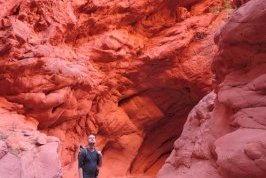
I will rate my experiece in this valley (quebrada in Quechua) independant of the only cultural aspect of the WHS. For me the natural/ landscape experience was more fascinating than the cultural aspect which is also interesting. Already the ride from Salta or Jujuy into Tilcara is a highlight. While driving uphill the landscape changes from green hills, forests and meadows into a dusty, red- brownish mountain landscape which sees mainly huge cactus growing. Maybe it is because I haven't travelled such a landscape before that I was quite happy but also others on the bus liked what they saw during the ride. Tilcara is quite a picturesque town. My family thought I'm in the Wild West when I have sent them pictures. We visited the Pueäcará de Tilcara within 1,5 hours in the evening of the first day which was sufficient. There is a flyer with some basic info available in English which doubles partly with some information signs in the fortress, that is more an ancient village than a defensive structure. Additionally there are guided tours in Spanish, which we didn't take. In addition to the historical aspect of the site I found the archeological controversies that happened here in the first half of the 20th century the most interesting. In short archeologists rebuilt parts of the Pucará (fortress in Quechua) but with wrong techniques and built a road that destroyed parts of the archeological site. Finally others build a monument for the archeologists within the site which …
Keep reading 0 comments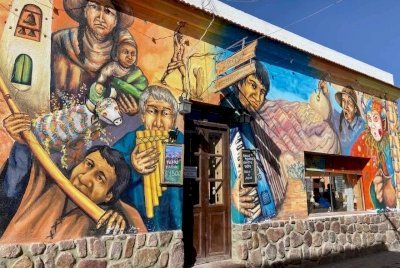
Originally when visiting Argentina, we planned to hire a car to visit the Quebrada de Humahuaca. However, a quick search online showed that there were multiple reasonably priced day trips leaving Salta visiting the valley, so we skipped sourcing a rental car and booked two tickets on a day trip.
We booked our day trip with Nordic Travel through Viator, for about $50 USD per person. Our bus seated about 25 passengers and we had a bilingual guide (although only four of us didn't speak Spanish) plus lunch was included.
The downside of doing an organised tour is that the stops are up to the tour company - for instance, our first proper stop was at a roadside cafe/shop with the longest toilet queues I've seen outside a festival. I enjoyed our first proper stop at Purmamarca, with just enough time to visit the church and a viewpoint for the Hills of Seven Colours, plus eat a local tortillas rellena. However, we only found out on the bus that as it was a Monday, the Pucara de Tilcara was closed, so we only stopped in town, which wasn't that interesting. We also ran out of things to do for our longish stop in Humahuaca - I most enjoyed the colourful street art. We also weren't expecting that with a 6:30am start time (well at least for pick-ups) and a 12 hour duration, that the tour wouldn't get back to Salta until 8:15pm, a narrow call for our overnight …
Keep reading 0 comments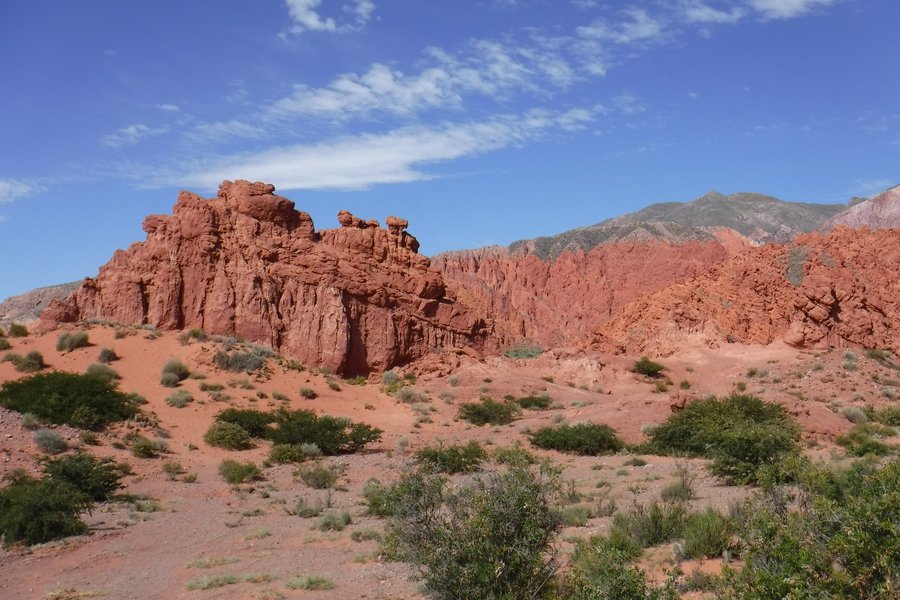
I visited Quebrada de Humahuaca in March 2022 after almost seven weeks in Argentina. Already in 2008, Els was surprised to write the very first review of this site, which is well on the classic path of backpackers and tourists in South America. It is even more surprising that only one other member of this community has visited the site and written a review since then and that this one dates back to 2009. Thirteen years later, I invite you on another four-day tour of the Quebrada. I spent three nights in a hostel in Tilcara, where I had come with a direct bus from Salta (beautiful city by the way).
First, after settling in at the hostel, I spent the rest of the afternoon surveying the Pucará de Tilcara and the adjacent Jardín Botánico de Altura. This ruined fortification is the main evidence of pre-Hispanic cultures in the area. The site is well laid out. They give you a pamphlet at the reception with the main information to understand the site. The problem is that this site and its visit is more of a lesson on what not to do as an archaeologist. You learn that the archaeologists of the mid-twentieth century rebuilt the dwellings with different materials and techniques than those used at the beginning, that they contaminated some areas of the site by transporting large quantities of soil and that they destroyed part of it to build the monument in homage to the archaeologists, a monument which, …
Keep reading 0 comments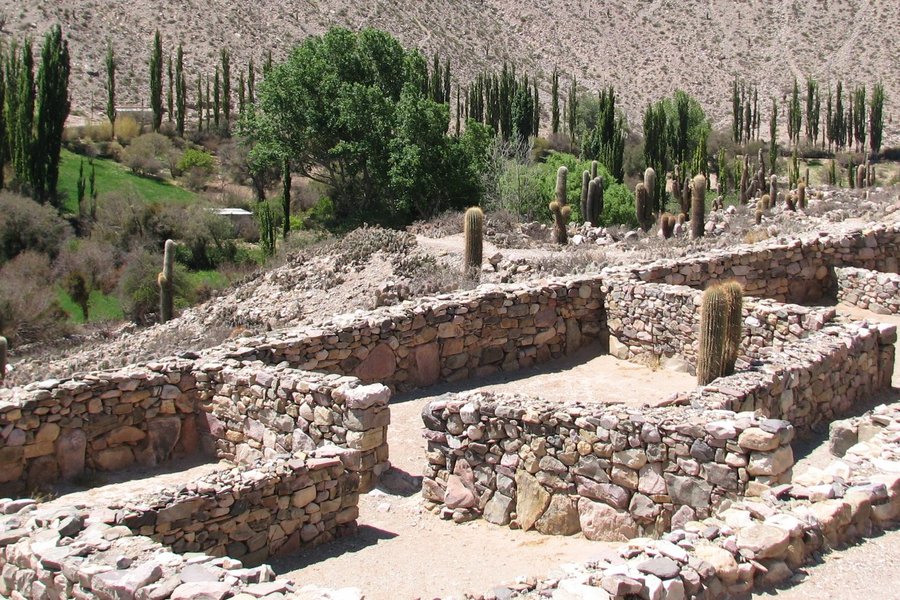
This was the first site I visited outside of Europe and the Middle East. It was a lucky choice since the area has a very distinct atmposphere from what I had known. The Quebrada is stunning in its natural setting and a very special place. In the Quebrada we visited Tilcara (where we stayed and I would recommend to stay) and nearby Purmamarca. Two special assets of the towns are their traditional colourful cemeteries filled with floral ornaments which are surprisingly cheerful, and the local Cuzco style paintings. If you want an interesting explanation about the Quechua influence on this local Baroque style (in Spanish) go to the Museum of Colonial Painting in Jujuy Capital. Local restaurants offer traditional Andean food and in some of them you can also listen to indigenous music.
Two nearby attractions I would recommend to visit while here are are the Salinas Grandes de Jujuy (second largest salt flats in the world after Uyuni, Bolivia) and Calilegua National Park.
Keep reading 0 comments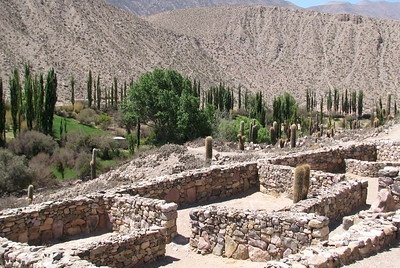
So this is the first review of the Quebrada de Humahuaca. Quite remarkable, as it is well on the beaten track for both overland South America travellers (it's close to the Bolivian-Argentine border) and regular Argentinian holidaymakers. Think of a sanitized version of the Andes, in a Colorado/Arizona landscape. I stayed here for four days, both in Purmamarca and Tilcara, and drove up and down the valley in a rental car.
The Quebrada has a relatively high population density, which differs from the many other valleys around Salta. The town of Purmamarca (population: 360) is quiet though: earthen roads, low adobe buildings, the smell of wood smoke in the streets in the evening and early morning, and scarce street lighting. It's a great little town to stay in. Its major landmark is the Seven Coloured Hill, which the town is exactly located in front of. The natural scenery is one of the major assets of the Quebrada de Humahuaca in general.
It wasn't put on the World Heritage List for its natural beauty, however. It's a 'cultural route', used by everyone from hunter-gatherers to independent Argentina. The tracks of the early groups aren't very easy to spot for the casual visitor. Most of what is visible left dates from the Spanish colonial times and later.
Driving north, the first historical building you encounter is the Posta de Hornillos. This is a 16th-century post for travellers to rest, modelled after the oriental caravanserais. It is now turned into …
Keep reading 0 comments
